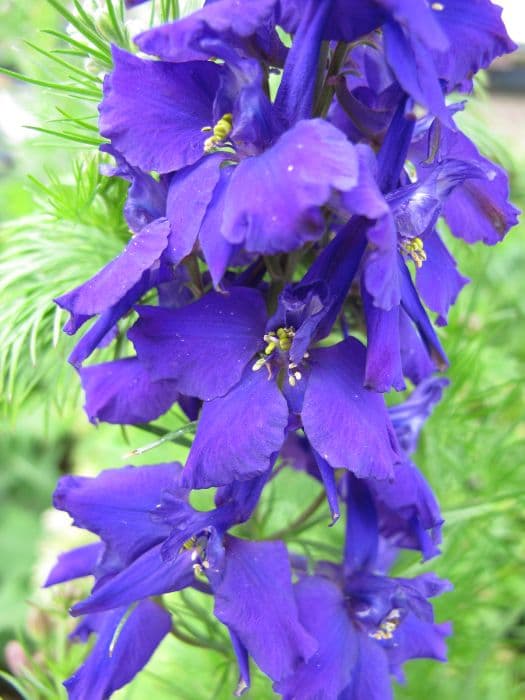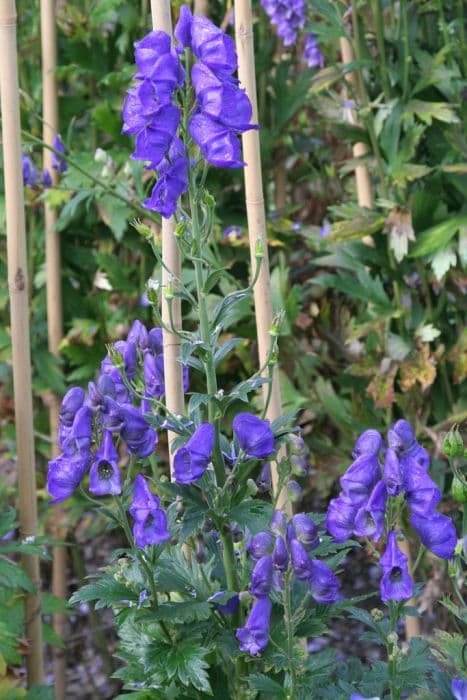Larkspur Consolida ajacis

ABOUT
Consolida ajacis, commonly known as Larkspur, is a visually striking plant characterized by its distinctive flowers and foliage. The blossoms of the Larkspur are its most notable feature, presenting in an elongated cluster along a singular, upright spike. These flowers come in a spectrum of colors, typically hues of blue, purple, pink, or white, and each individual bloom resembles a small, irregularly shaped helmet or spurred knight's cap, which contributes to the plant's overall whimsical appearance. The petals are often intricately detailed, with a prominent spur at the back, giving the flowers a unique and elegant profile. This spur is one of the clearest identifying features of the Larkspur flower. The plant's foliage is equally delicate, comprising of fine, deeply cut leaves that are almost feathery in texture. These leaves are usually arranged in an alternate pattern along the stems, providing a lacy backdrop that contrasts beautifully with the bold, upright flower spikes. Overall, the Larkspur's appearance is defined by the vertical lines of its floral spikes and the soft, finely dissected nature of its greenery, which together create a striking and picturesque presence in any garden or floral arrangement where the exact size of the plant isn't the focus.
About this plant
 Names
NamesFamily
Ranunculaceae.
Synonyms
Larkspur, Doubtful Knight's Spur, Rocket Larkspur, Annual Delphinium, Giant Larkspur.
Common names
Consolida ambigua, Delphinium ajacis, Delphinium ambiguum.
 Toxicity
ToxicityTo humans
Larkspur, specifically Consolida ajacis, is toxic to humans if ingested. All parts of the plant contain poisonous alkaloids, with the seeds being particularly potent. Symptoms of larkspur poisoning can include nausea, vomiting, abdominal pain, muscle weakness, stiffness, tremors, convulsions, and can potentially lead to cardiac problems or respiratory failure which can be fatal if not treated promptly.
To pets
Larkspur is also toxic to pets, including dogs, cats, and horses, among others. The toxicity is due to the same alkaloids that affect humans. Symptoms in pets may include drooling, weakness, vomiting, diarrhea, muscle tremors, stiffness, convulsions, and potentially leading to cardiac failure or respiratory paralysis. It is particularly dangerous for cattle and other livestock and can be fatal if not treated by a veterinarian immediately.
 Characteristics
CharacteristicsLife cycle
Annuals
Foliage type
Deciduous
Color of leaves
Green
Flower color
Varies
Height
2-3 feet (0.6-0.9 meters)
Spread
1 foot (0.3 meters)
Plant type
Herb
Hardiness zones
2-10
Native area
Europe
Benefits
 General Benefits
General Benefits- Ornamental Value: Consolida ajacis, commonly known as larkspur, is valued for its tall spikes of colorful flowers that enhance the beauty of gardens and landscapes.
- Attracts Pollinators: The plant is known to attract bees, butterflies, and other pollinating insects, which are essential for the pollination of many plants and crops.
- Cut Flower Use: Larkspur is popular in floral arrangements due to its long vase life and striking appearance, making it a favorite among gardeners and florists alike.
- Companion Planting: Gardeners often use larkspur in companion planting to help deter certain pests from more sensitive plants in the garden.
- Variety of Colors: Larkspur flowers come in a range of colors, including blue, purple, pink, and white, offering a wide palette for garden design.
- Self-seeding: It is capable of self-seeding under appropriate conditions, which can result in new plants growing in subsequent years without additional sowing.
- Cultural Significance: Larkspur has various cultural meanings and is often associated with positive symbolism such as love, affection, and strong bonds.
 Medical Properties
Medical Properties- Analgesic: Traditionally used to relieve pain.
- Anti-inflammatory: May reduce inflammation in certain conditions.
- Diuretic: Sometimes used to promote the excretion of urine.
 Air-purifying Qualities
Air-purifying QualitiesThis plant is not specifically known for air purifying qualities.
 Other Uses
Other Uses- As a dye plant: Larkspur can be used to create a blue dye, historically utilized in fabric and textile coloring.
- In flower arrangements: The tall and showy spikes of larkspur make it a popular choice for fresh and dried floral arrangements.
- As a teaching tool in botany: Due to its distinct flower structure, larkspur is used for educational purposes to illustrate the anatomy of flowers.
- In companion planting: Larkspur is sometimes planted with vegetables to attract pollinators and beneficial insects to the garden.
- For cut flower production: Larkspur is commercially cultivated for its cut flowers which are popular in the floristry industry.
- As a natural pest deterrent: Certain compounds found in larkspur are utilized in gardens to repel specific pests.
- In garden design: The vertical growth habit and vibrant colors of larkspur are used to create focal points and contrast in landscape design.
- For ink production: The pigments in larkspur flowers have been used in the past to make natural inks for writing and art.
- As a ground stabilizer: The root system of larkspur can help prevent soil erosion on slopes and embankments.
- For ornamental crafts: Dried larkspur stems and flowers can be used in the creation of wreaths and other decorative items.
Interesting Facts
 Feng Shui
Feng ShuiThe plant Consolida ajacis, more commonly known as Larkspur, is not used in Feng Shui practice.
 Zodiac Sign Compitability
Zodiac Sign CompitabilityThe plant Larkspur is not used in astrology practice.
 Plant Symbolism
Plant Symbolism- Fun and Fickleness: Often associated with fun due to its light and airy blossoms, Consolida ajacis, commonly known as Larkspur, represents a whimsical or even a fickle nature, possibly reflecting the variety of colors and the flower's delicate form.
- Youthful Spirit: Larkspur symbolizes a youthful spirit and the joy of life, embodying positivity and the carefree days of youth with its vibrantly colored petals.
- Open Heart: The flower's open shape is suggestive of an open heart, symbolizing openness to new emotions and the readiness to share feelings with others.
- Ardent Attachment: Some cultures view Larkspur as a symbol of strong attachment or a declaration of love, often used in bouquets to express deep affection.
- Protection: In some folklore, Larkspur is believed to have protective properties, warding off ghosts and negative energies, representing a shield against harm.
- Variety and Change: With a host of colors and shapes, Larkspur can also symbolize variety, change, and transition, reflecting life’s constant flux.
 Water
WaterLarkspur, commonly known as Consolida ajacis, prefers consistent moisture but does not like to sit in waterlogged soil. Water the plant deeply once a week, providing enough water to saturate the root zone. Depending on weather conditions, this could be equivalent to about 1 inch of rainfall or roughly 0.62 gallons per square foot of soil area, ensuring the soil dries slightly between waterings. During hot or dry spells, you may need to water the larkspur twice a week. Always check the top inch of soil for dryness before watering again to prevent overwatering.
 Light
LightLarkspur requires full sun conditions to thrive, which means they should get at least 6 to 8 hours of direct sunlight each day. Place them in a spot where they'll be exposed to unfiltered sunlight throughout the majority of the day. They can tolerate some light shade, especially in regions with very hot summers, but too much shade can lead to weak growth and fewer blooms.
 Temperature
TemperatureLarkspur enjoys moderate temperatures and can generally withstand a range between 40 to 85 degrees Fahrenheit. The ideal temperature range for growing larkspur is between 65 and 75 degrees Fahrenheit. They are cool-season plants and may struggle or become dormant in the high heat of summer, especially if temperatures exceed 85 degrees Fahrenheit.
 Pruning
PruningLarkspur should be pruned to encourage bushier growth and more blooms. Deadhead spent flowers regularly to promote continued blooming throughout the season. After the first flush of blooms has finished, cut back the flower stalks by half to stimulate a second flowering period. Pruning is best done after the initial bloom peak, which is typically in early to mid-summer.
 Cleaning
CleaningAs needed
 Soil
SoilLarkspur thrives in well-draining, moderately fertile soil with a pH range of 6.1 to 7.8. A good mix would be equal parts loam, peat, and sand to ensure proper drainage and aeration.
 Repotting
RepottingLarkspurs are generally not repotted as they are annual plants; after flowering, they complete their life cycle and are sown anew each season.
 Humidity & Misting
Humidity & MistingLarkspurs prefer moderate humidity but are quite adaptable and can tolerate a range of atmospheric moisture conditions without requiring specific adjustments.
 Suitable locations
Suitable locationsIndoor
Ensure bright light, cool temperatures, and well-draining soil for indoor Larkspur growth.
Outdoor
Full sun, well-drained soil, and protection from strong winds suit outdoor Larkspur.
Hardiness zone
2-10 USDA
 Life cycle
Life cycleConsolida ajacis, commonly known as larkspur, begins its life cycle when seeds are sown in the soil, where they germinate under appropriate temperature and moisture conditions. The seedlings quickly establish a root system and sprout a set of true leaves after the initial cotyledons appear. As the plant grows, it develops a tall spire adorned with deeply lobed leaves and a stem that becomes sturdy to support the flowering stalk. Flowering occurs in the early summer, with the larkspur producing a showy raceme of colorful flowers that are attractive to pollinators. After pollination, the flowers develop into fruit containing seeds, which upon maturation are dispersed by wind or other mechanisms. Larkspur completes its life cycle as an annual, dying after seed production, and relies on the new generation of seeds for propagation the following season.
 Propogation
PropogationPropogation time
Spring-Early Summer
Larkspur, commonly known as Consolida ajacis, is most successfully propagated through its seeds. The best time to sow Larkspur seeds is in early spring, following the last frost when the soil is workable, or in autumn if you have mild winters. For spring planting, you can start the seeds indoors in seed trays with well-draining soil about 6 to 8 weeks before the last expected frost; then, transplant them into the garden once the weather stabilizes. Larkspur seeds need light to germinate, so do not cover them with soil or only press them lightly into the soil surface. Keep the soil moist but not waterlogged; germination usually occurs within 2 to 3 weeks. Once seedlings are large enough to handle and after hardening them off, space them about 8 inches (20 centimeters) apart to allow for proper growth and air circulation. This method capitalizes on the plant's prolific self-seeding nature and yields a beautiful crop of these tall, spiky flowers.









